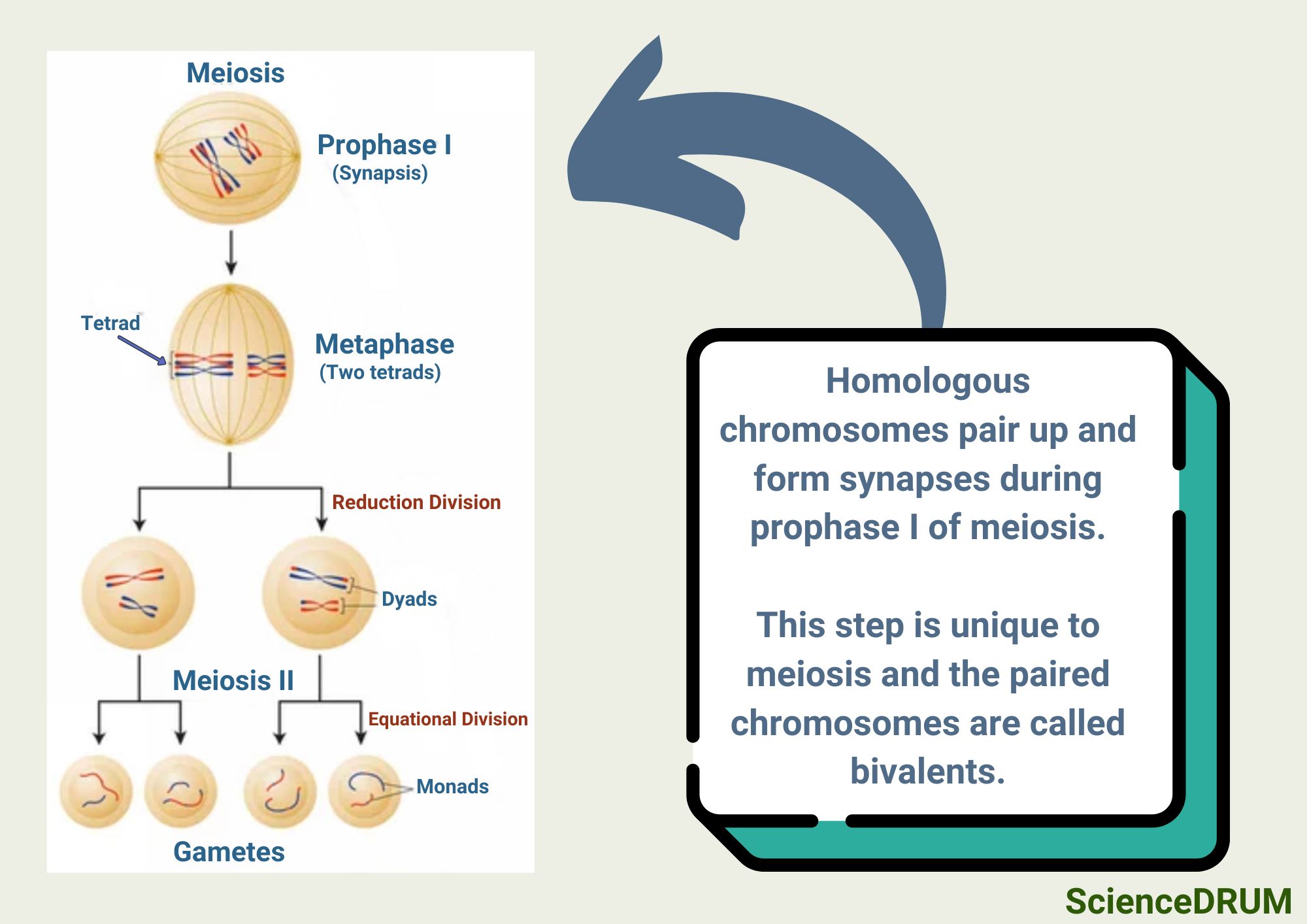
Homologous chromosomes pair up and form synapses during prophase I of meiosis. This step is unique to meiosis and the paired chromosomes are called bivalents.
This article explains the significance of homologous chromosomes, the function of the synaptonemal complex in homologous chromosome pairing, and the causes and consequences of errors in homologous chromosomes pairing.
The Significance of Homologous Chromosomes in Meiosis
Meiosis is the process by which cells divide to produce gametes, or sex cells. Unlike mitosis, which produces two identical daughter cells, meiosis produces four genetically diverse daughter cells.
This is due in large part to the pairing of homologous chromosomes during meiosis I.
Homologous chromosomes are important because they allow for genetic recombination, which is the process by which genetic material from the mother and father is mixed and shuffled, resulting in a unique combination of genetic material in each offspring.
This genetic recombination occurs during two key processes in meiosis I — synapsis and crossing over. Synapsis is the process by which homologous chromosomes pair up and form a structure called a bivalent or tetrad.
This pairing allows for the exchange of genetic material between the homologous chromosomes. During synapsis, proteins called synaptonemal complexes hold the homologous chromosomes together, ensuring that they remain paired until the next phase of meiosis.
Crossing over is the process by which genetic material is exchanged between the homologous chromosomes. This occurs at points called chiasmata, which form between the paired homologous chromosomes during synapsis.
The exchange of genetic material between the homologous chromosomes results in new combinations of genes, which contributes to genetic diversity in offspring. The significance of homologous chromosomes in meiosis extends beyond genetic diversity.
Homologous chromosomes also play a role in ensuring that the daughter cells produced during meiosis have the correct number of chromosomes.
During meiosis, the homologous chromosomes break apart, so that each daughter cell receives only one copy of each chromosome.
At What Point During Meiosis Do Homologous Chromosomes Pair Up?

Prophase I is the first stage of meiosis I, where homologous chromosomes pair up and form bivalent structures called a tetrad through a process called synapsis. During synapsis, homologous chromosomes are held together by protein structures called synaptonemal complexes. {1}
The pairing up of the homologous chromosomes enables recombination, which is responsible for the genetic differences in siblings, who have the same parents.
Once homologous chromosomes have paired up during meiosis I, they undergo separation during anaphase I, resulting in the production of two daughter cells, each with half the number of chromosomes as the original cell.
The Role of the Synaptonemal Complex in Chromosome Pairing
The synaptonemal complex (SC) is made up of two lateral elements that run parallel to each other along the length of the homologous chromosomes. These lateral elements are connected by a central element that runs down the center of the complex. {2}
The central element of the synaptonemal complex is responsible for the tight alignment of the homologous chromosomes, ensuring that they stay paired throughout the remainder of meiosis.
The SC ensures that each chromosome pairs with its homologous partner, allowing for the proper segregation of chromosomes and the production of genetically diverse gametes.
Crossing over occurs when the lateral elements of the synaptonemal complex bring the homologous chromosomes into close proximity, allowing for the exchange of genetic material between the chromosomes.
Errors in Homologous Chromosome Pairing: Causes and Consequences
Errors in homologous chromosome pairing during meiosis can result in chromosomal abnormalities and genetic disorders in offspring. These errors can occur due to various causes and can lead to serious consequences in the normal development of the offspring.
Causes of Errors in Homologous Chromosome Pairing
One cause of errors in homologous chromosome pairing is genetic mutations. Mutations in genes that regulate meiosis can result in defects in homologous chromosome pairing, leading to the production of abnormal gametes.
Environmental factors can also lead to errors in homologous chromosome pairing. Exposure to radiation, chemicals, and other environmental toxins can damage DNA, resulting in abnormalities in chromosome pairing and segregation during meiosis.
Errors during meiosis, such as nondisjunction, can also result in errors in homologous chromosome pairing. Nondisjunction occurs when the homologous chromosomes don’t detach properly during meiosis, resulting in the production of gametes with an abnormal number of chromosomes.
Consequences of Errors in Homologous Chromosome Pairing
The consequences of errors in homologous chromosome pairing depend on the type and severity of the abnormality. Some chromosomal abnormalities may not have any significant effects, while others can lead to developmental disorders, intellectual disabilities, and other health problems.
Examples of chromosomal abnormalities caused by errors in homologous chromosome pairing include Down syndrome, Turner syndrome, and Klinefelter syndrome. Down syndrome is caused by an extra copy of chromosome 21, resulting in intellectual disabilities and other developmental disorders.
Turner syndrome is caused by the absence of one of the X chromosomes, resulting in infertility and other health problems. Klinefelter syndrome is caused by the presence of an extra X chromosome, resulting in infertility and other health problems. {3}
Abnormalities in chromosome pairing can result in the production of gametes with an abnormal number of chromosomes, which can prevent fertilization and the production of viable offspring.
Sources:
1 – The University of Arizona: “Meiosis I & II.”
3 – Reviews in Urology: “Infertility in Patients With Klinefelter Syndrome: Optimal Timing for Sperm and Testicular Tissue Cryopreservation.”